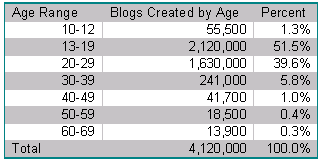Perseus Development Corp. randomly surveyed 3,634 blogs on eight leading blog-hosting services to develop a model of blog populations. Based on this research, Perseus estimates that 4.12 million blogs have been created on these services: Blog-City, BlogSpot, Diaryland, LiveJournal, Pitas, TypePad, Weblogger and Xanga.
Abandoned Blogs
The most dramatic finding was that 66.0% of surveyed blogs had not been updated in two months, representing 2.72 million blogs that have been either permanently or temporarily abandoned. Apparently the blog-hosting services have made it so easy to create a blog that many tire-kickers feel no commitment to continuing the blog they initiate. In fact, 1.09 million blogs were one-day wonders, with no postings on subsequent days. The average duration of the remaining 1.63 million abandoned blogs was 126 days (almost four months). A surprising 132,000 blogs were abandoned after being maintained a year or more (the oldest abandoned blog surveyed had been maintained for 923 days).
Males were more likely than females to abandon blogs, with 46.4% of abandoned blogs created by males, as compared to 40.7% of active blogs being created by males. Abandonment rates did not vary based on age. Those who abandoned blogs tended to write posts that were only 58% as long as the posts of those who still maintained blogs, which simply indicates that those who enjoy writing stick with blogs longer.
The abandonment rate did vary significantly based on which service was being used: Pitas, BlogSpot and Diaryland had above average abandonment rates; Xanga had an average abandonment rate; LiveJournal had the lowest abandonment rate (the sample size for Blog-City, TypePad and Weblogger was too low to compare).
Active Blogs
Blogs are famed for their linkages, and while 80.8% of active blogs linked to at least one external site from a post on their home page, these links were rarely to traditional news sources. Only 9.9% of active blogs had a current post that linked to one of 2,875 traditional news sites. So blogging in practice is not just about linking to news articles.
Blogs are updated much less often than generally thought. Active blogs were updated on average every 14 days. Only 106,579 of the hosted blogs were updated on average at least once a week. Fewer than 50,000 were updated daily.
Only 13,600 blogs were resumed after being abandoned. These blogs had been recently updated when surveyed, despite previously having been updated on average every 112 days.
The average home page of the active blogger included posts for eight unique days. Home page size was 26.4KB (excluding images and external code such as JavaScript or style sheets).
Demographics
Even as MP3 sharing and instant messaging began with teenagers, teenagers have created the majority of blogs. Blogs are currently the province of the young, with 92.4% of blogs created by people under the age of 30.


Females are slightly more likely than males to create blogs, accounting for 56.0% of hosted blogs.


Forecast
Based on the rapid growth rate demonstrated by the leading services, we expect the number of hosted blogs created to exceed five million by the end of 2003 and to exceed ten million by the end of 2004.


BlogSpot and LiveJournal are the two market leaders, each with 31% of these hosted blogs. While BlogSpot is growing more quickly, its retention rate is lower, and the two sites should continue to race neck-and-neck in the near term in terms of active users.
Conclusions
When you say “blog” most people think of the most popular weblogs, which are often updated multiple times a day and which by definition have tens of thousands of daily readers. These make up the tip of a very deep iceberg: prominently visible, but not characteristic of the iceberg as a whole.
What is below the water line are the literally millions of blogs that are rarely pointed to by others, since they are only of interest to the family, friends, fellow students and co-workers of their teenage and 20-something bloggers. Think of them as blogs for nanoaudiences.
Nanoaudiences are the logical outcome of continued growth in blogs. Assume for a moment that one day 100 million people regularly read blogs and that they each read 50 other peoples€ blogs. That translates into 5 billion subscriptions (50 * 100 million). Now assume on that same day there are 20 million active bloggers. That translates into 250 readers per blog (5 billion / 20 million) – far smaller audiences than any traditional one-to-many communication method. And this is just an average; in practice many blogs have no more than two dozen readers.
Blogging is many things, yet the typical blog is written by a teenage girl who uses it twice a month to update her friends and classmates on happenings in her life. It will be written very informally (often in “unicase”: long stretches of lowercase with ALL CAPS used for emphasis) with slang spellings, yet will not be as informal as instant messaging conversations (which are riddled with typos and abbreviations). Underneath the iceberg, blogging is a social phenomenon: persistent messaging for young adults.
An iceberg is constantly dissolving into sea water, and the majority of blogs started are dissolving into static, abandoned web pages. Right now, though, this iceberg is moving so quickly into arctic waters that it is gaining mass faster than it is losing it. The key is that an iceberg is never what it appears, and so it is with today€s blogging community.
— Jeffrey Henning
COO
Perseus Development Corp.